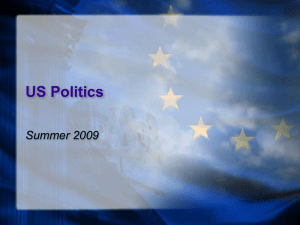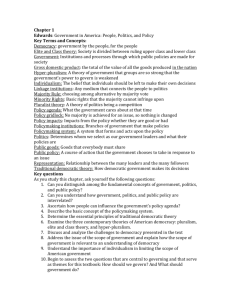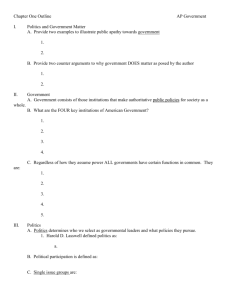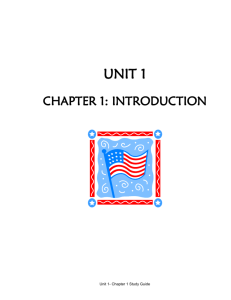Chapter 1: Theory of Modern Government
advertisement
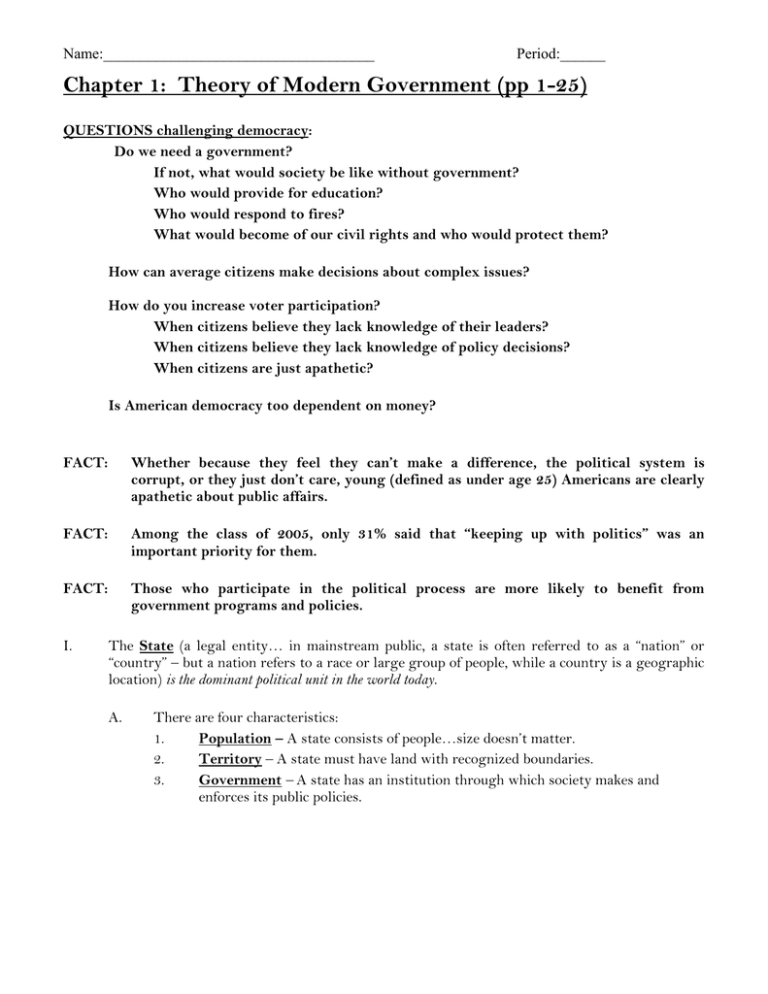
Name:____________________________________ Period:______ Chapter 1: Theory of Modern Government (pp 1-25) QUESTIONS challenging democracy: Do we need a government? If not, what would society be like without government? Who would provide for education? Who would respond to fires? What would become of our civil rights and who would protect them? How can average citizens make decisions about complex issues? How do you increase voter participation? When citizens believe they lack knowledge of their leaders? When citizens believe they lack knowledge of policy decisions? When citizens are just apathetic? Is American democracy too dependent on money? FACT: Whether because they feel they can’t make a difference, the political system is corrupt, or they just don’t care, young (defined as under age 25) Americans are clearly apathetic about public affairs. FACT: Among the class of 2005, only 31% said that “keeping up with politics” was an important priority for them. FACT: Those who participate in the political process are more likely to benefit from government programs and policies. I. The State (a legal entity… in mainstream public, a state is often referred to as a “nation” or “country” – but a nation refers to a race or large group of people, while a country is a geographic location) is the dominant political unit in the world today. A. There are four characteristics: 1. Population – A state consists of people…size doesn’t matter. 2. Territory – A state must have land with recognized boundaries. 3. Government – A state has an institution through which society makes and enforces its public policies. Chapter 1 Notes Page 2 of 8 4. Sovereignty – A state has supreme and absolute power within its own territory… it is neither subordinate nor responsible to any other authority. a) The Virgin Islands, Guam, and the states within the United States are not sovereign because they are “responsible” to the United States. b) If the people are sovereign (people hold the power), then the government is democratic; however, if a single person or a small group holds the power, a dictatorship exists. B. II. The United States is based on the Social Contract Theory where people agreed to give up power to the state in return for the state’s service to the general well-being of the people. 1. It was developed to challenge the idea that those of royal birth have absolute authority to rule; the people don’t have to be subordinate to an autocracy. 2. In the case of the United States, the “contract” would be the Constitution. What is government…our savior or our torment? (pages 8-10) A. A working definition of government is the institutions through which a society makes and enforces its public policies (all those things a government decides to do). 1. Imposing income tax 2. Setting a minimum wage 3. Maintaining large, combat-ready armed forces B. The United States is comprised of a Federal Government. 1. A working definition of federalism is a system in which powers of government are divided between the National Government and the 50 States. 2. The division of powers was set out in the Constitution, which stands above both levels of government, through the 10th Amendment. 3. Federalism allows local actions in matters of local concern and national action in matters of wider concern. C. Four key policymaking institutions at the national level: 1. The Legislative Branch (a/k/a Congress) – the power to make law and to frame public policies. 2. The Executive Branch (a/k/a President) – the power to execute, enforce, and administer law. 3. The Judicial Branch (a/k/a The Supreme Court and lower courts) – the power to interpret laws, to determine the meaning, and to settle disputes that arise within the society. 4. The Bureaucracy (a/k/a Federal Administrative Agencies) – including regulatory agencies and government corporations. Chapter 1 Notes Page 3 of 8 D. III. What do governments do anyway? In the Preamble to the Constitution, the six purposes (objectives) of government in the United States are presented: 1. To Form a More Perfect Union – In union there is strength. 2. To Establish Justice – The law, in its content and administration, must be reasonable, fair, and impartial. 3. To Insure Domestic Tranquility – Having police powers to provide order; without order, people would live in anarchy (this deals with peace at home). 4. Provide for the Common Defense – The security of the U.S. requires (a) a wise defense and (b) wise foreign policies. 5. To Promote the General Welfare – The state has a responsibility to provide a variety of public goods (things that are indivisible, nonexclusive, and that EVERYONE can share and not denied; i.e., clean air and public school) and public services (can be restricted to certain individuals based on criteria; i.e., college education and Medicare). 6. To Secure the Blessings of Liberty – Freedom is necessary, but cannot be absolute. It’s All about the Politics (pages 10-11) A. Politics is the process by which we select our governmental leaders and what policies these leaders pursue. [Government + Politics = Public Policy] In other words, what government does through politics results in public policy. 1. Harold D. Lasswell, a political analyst, defined politics as “who gets what, when, and how.” a) “Who of Politics” includes voters, candidates, groups, and parties b) “What of Politics” is the substance; i.e., benefits such as medical care for the elderly AND burdens such as new taxes c) “How of Politics” is through voting, supporting, compromising, lobbying, etc. d) “Why of Politics” is their ability to succeed or fail in getting elected and/or making policy. B. Political Participation refers to the ways in which people get involved in politics. 1. Voting is the most common form of political participation; however, America does quite poorly with one of the lowest rates of voter participation in the world. 2. Protests and Civil Disobedience are other examples of participation. C. Single-issue groups are interest groups whose members will vote on a single issue. 1. Pro-life (National Right to Life Committee) and Pro-choice (National Abortion Rights Action League) are single-issue groups that ignore a politician’s stand on everything EXCEPT abortion. 2. National Rifle Association (NRA) and National Coalition to Ban Handguns (NCBH) are single-issue groups that ignore politician’s stand on everything EXCEPT gun control. Chapter 1 Notes Page 4 of 8 D. IV. Political Ideologies is a coherent set of beliefs about politics, public policy, and public purpose. It helps give meaning to political events, personalities, and policies. In the United States, we tend to focus beliefs into two ideologies: 1. Conservatives (a.k.a. Republicans, GOP, the right, mascot = elephant) prefer a government based on tradition and social stability, prefer less government in the daily lives of citizens, stressing established institutions (versus creating new ones), and preferring gradual development to abrupt change. 2. Liberals (a.k.a. Democrats, the left, mascot = donkey) prefer a government active in dealing with human needs, support individual rights and liberties, and give higher priority to social needs than to military needs. The Policymaking System (pages 11-14) is a set of institutions and activities that link together government, policies, and public policy. A. When people confront government officials with problems they expect them to solve, they are trying to influence the government’s policy agenda (the list of subjects or problems to which people inside and outside government are paying serious attention at any given time). B. Linkage institutions connect the preferences of citizens to the government’s policy agenda. 1. Parties and Interest Groups strive to ensure that their members’ concerns receive appropriate political attention. 2. The media investigates social problems and informs people about them. 3. Elections allow citizens the chance to make their opinions heard by choosing their public officials. C. A political issue arises when people disagree about a problem or about a public policy choice made to combat a problem. Chapter 1 Notes Page 5 of 8 D. Policymaking Institutions are the branches of government (Executive, Legislative, Judicial, and Bureaucracy) charged with taking action on political issues. 1. Executive Branch – a) The president as chief executive proposes to Congress a legislative agenda. b) Along with the agenda is a budget proposal that defines the extent of government involvement in supporting legislation as well as the size of government. c) The decision to sign or veto legislation determines the fate of legislation and the resulting public policy. 2. Legislative Branch – a) Congress, through its committee system and ultimately its votes, determines the fate of the president’s legislative agenda and the proposed budget. b) Over the past 30 years, the issue of the nation’s deficit has been paramount in determining the nature of legislation passed. c) This changed in 1996 after President Clinton signed a balanced budget. d) By 2000 the debate shifted away from deficit spending to what the budget surplus should be used for. e) After September 11, 2001, tax cuts, a recession, and an expanded war on terrorism resulted in the return of large deficits. 3. Judicial Branch – a) Supreme Court has a direct impact on the public policy through its interpretations of the Constitution and how it relates to specific issues brought before the Court. b) An activist Court will forge new ground and through such decisions as Roe v. Wade or Brown v. Board of Education establish precedents that will force legislative action. c) A Court that shows judicial restraint will maintain the status quo or mirror what the other branches of government have established as current policy. d) Decisions that established the legitimacy of state restrictions on abortions such as parental approval, and a narrower interpretation of Miranda Rights were characteristic of a more conservative Rehnquist Court in the late 1980s and 1990s. Chapter 1 Notes Page 6 of 8 4. V. Bureaucracy – The size of government increased since WWII as a result of the bureaucracy, which became an integral part of the government. a) Regulatory agencies such as the Food and Drug Administration (FDA) and the Environmental Protection Agency (EPA) have issued directives as a result of congressional legislation. b) The Clean Air Act resulted in a number of policy statements by the EPA regarding auto pollution in the individual states. c) The FDA debated the advisability of approving the abortion pill RU486 and gave the go-ahead for a private group to conduct testing; ultimately approving the drug in 2000 for consumer use. E. The end product of government and politics is public policy (every decision that government makes - every law it passes, budget it establishes, ruling it hands down, or even inaction). F. Policy Impacts are the effects policy has on people and on society’s problems. 1. Having a policy implies a goal: people who raise a policy issue usually want a policy that works. 2. Policy impact analysts ask how well a policy achieves its goal – and at what cost 3. Translating people’s desires into public policy is crucial to the workings of democracy. Democracy (pages 14-20) is a form of government in which the people govern, either directly (direct democracy where the will of the people is translated into public policy directly by the people) or through elected representatives (representative democracy a/k/a indirect democracy where a small group of persons chosen by the people to act as their representatives expresses the popular will). In the U.S. democracy is a system of selecting policymakers and of organizing government so that policy represents and responds to the public’s preferences. A. Defining Democracy (pages 14-15) 1. Writers of the U.S. Constitution doubted the ability of ordinary Americans to make informed judgments about what government should do. 2. Abraham Lincoln defined democracy in his Gettysburg Address as “government of the people, by the people, and for the people.” a) Of the People – The Constitution forbids the granting of titles of nobility. b) By the People – It is a physical impossibility for government with a society of 285 million people. c) B. For the People – This is questionable in looking at how well leaders represent the needs of the people. Traditional Democratic Theory rests upon several principles that specify how a democratic government makes its decisions. Democracy does NOT exist in the United States simply because Americans regard it as the best of all possible political systems. Chapter 1 Notes Page 7 of 8 Rather, democracy exists in this country because the American people believe in its basic concepts. It will continue to exist only for as long as we, THE PEOPLE, continue to subscribe to and practice those concepts. An ideal democratic process should satisfy five criteria: 1. Worth of the Individual / Inclusion – Each person’s worth and dignity must be recognized and respected by all other individuals, and by society at all times. However, at various times, the welfare of one or a few individuals is subordinate to the interests of the many. 2. Equality of All Persons a) Each person is free to develop him/herself as fully as he/she can. b) It is also the aspect of equality before the law. c) Equality in voting and Universal Suffrage is essential. The principle of “one person, one vote” is basic to democracy. Citizens must have adequate and equal opportunities to express their preferences throughout the decision-making process. 3. Majority Rule (the will of over half the voters should be followed) with Minority Rights (guarantees rights to those who do not belong to the majority voice) is essential. 4. Necessity of Compromise – Compromise allows citizens to have the collective right to control the government’s policy agenda. a) It is the process of blending, adjusting, and reconciling competing views and interests. b) Policy gridlock is a condition that occurs when no coalition is strong enough to form a majority and establish policy; the result is that nothing may get done. (1) Occurred during the George Herbert Walker Bush administration because the Republican president had difficultly achieving his legislative agenda with the Democrat congress. (2) Can also occur when the legislative houses are split between partisan lines; i.e., a Republican House and a Democrat Senate. 5. Individual Freedom - A democratic society must be a marketplace of ideas with free speech and free press essential to civic understanding. Freedom cannot be absolute, or anarchy will result. Justice Oliver Wendall Holmes explained the balance of individual rights with freedom as “the right to swing my fist ends where the other man’s nose begins.” C. Representation (a/k/a representative democracy) describes the relationship between the few leaders and the many followers. The desires of the people should be replicated in government through the choices of elected officials. Chapter 1 Notes Page 8 of 8 D. Three Contemporary Theories of American Democracy (pages 16-18) 1. Pluralist Theory - Groups with shared interests influence public policy by pressing their concerns through organized efforts. a) Believe that rather than speaking of majority rule, we should speak of groups of minorities working together. b) Interest groups and lobbyists have become masters of the technology of politics and prevail in proving Alexis de Tocqueville’s writing that we are a “nation of joiners.” c) Robert Putnam argues that many of the problems of American democracy stem from the decline in group-based participation. People can now “individually” participate by writing a check to the lobbyist while never “actively” participating in the group. 2. Elite and Class Theory contends that our society is divided along class lines and that an upper-class elite pulls the strings of government. a) Over a third of the nation’s wealth is held by 1% of the population and it is them that control most policy decisions because they can afford to finance election campaigns and control key institutions. b) President Ronald Reagan succeeded in ensuring big business’s dominance in politics. c) Who holds office in Washington is of marginal consequence; the corporate giants always have the power. 3. Hyperpluralism Theory believes that groups are so strong that government is weakened or even unable to act. a) Our fragmented political system contributes to hyperpluralism by having too many interests vying for government’s attention, making it difficult to coordinate policy implementation. b) Believes that groups have become sovereign and government is its servant. Unfortunately government gives in to every conceivable interest and singleissue group that when politicians try to placate every group, the result is confusing, contradictory, and muddled policy.

